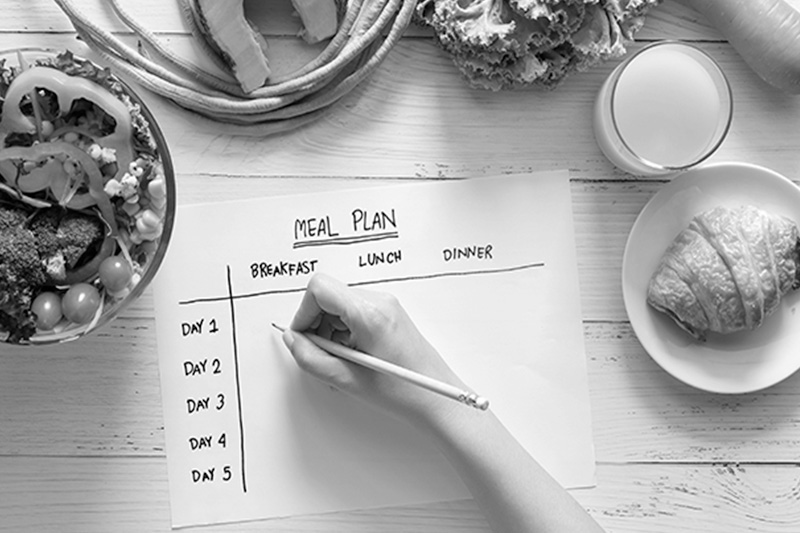Starting a meal plan can feel overwhelming, but with the right approach, it doesn’t have to be. A meal plan helps you stay organized, saves time, and makes it easier to stick to your nutritional goals. Whether you’re aiming to lose weight, build muscle, or simply eat healthier, this guide will walk you through the basics of setting up a beginner-friendly meal plan that works for your lifestyle and goals. Let’s dive in!
Why Create a Meal Plan?
When you create a meal plan, you’re setting yourself up for success by establishing a roadmap for your eating habits. Here are a few benefits:
- Saves Time and Money: You’re less likely to buy extra items or waste food, which can help reduce your grocery bill.
- Helps You Stick to Your Goals: Having a plan in place makes it easier to avoid impulse eating or unhealthy options.
- Promotes Healthy Choices: When you have healthy, nutritious meals planned, you’re more likely to skip junk food.
- Reduces Stress: Deciding what to eat each day can be exhausting. A meal plan eliminates the guesswork.
Step 1: Define Your Goals
Before you start planning, think about what you want to achieve with your meals. Are you aiming for weight loss, building muscle, or just eating balanced meals? Your goals will help guide the types of foods you include in your plan.
For example:
- Weight Loss: Focus on nutrient-dense, lower-calorie foods that keep you full.
- Muscle Gain: Add protein-rich foods to help build and repair muscles.
- Balanced Diet: Aim for a variety of whole foods to ensure you’re getting all the necessary nutrients.
Once you’ve set a goal, it’s easier to decide what your meals should look like each day.
Step 2: Choose Simple, Balanced Meals
As a beginner, sticking to simple, balanced meals is key. Each meal should include a source of protein, carbohydrates, healthy fats, and plenty of fruits and vegetables. Here’s a basic breakdown of these components:
- Protein: Chicken, fish, tofu, beans, eggs
- Carbohydrates: Rice, quinoa, whole grains, sweet potatoes, oats
- Healthy Fats: Olive oil, nuts, seeds, avocados
- Fruits and Vegetables: Leafy greens, berries, broccoli, carrots, bell peppers
Aim for balance on your plate, roughly half vegetables, a quarter protein, and a quarter carbs, with a small amount of healthy fat.
Step 3: Plan Your Meals
Start by planning your meals for the week. Here’s a basic outline that might help:
- Breakfast: Go for something that will give you sustained energy throughout the morning. Options like oatmeal with fruit, a veggie omelet, or Greek yogurt with nuts and berries are filling and nutritious.
- Lunch: Keep it simple but balanced. Try a salad with grilled chicken and a side of whole grains, a wrap with lean protein and veggies, or a Buddha bowl with greens, grains, and protein.
- Dinner: For dinner, consider options like grilled salmon with roasted vegetables, a veggie stir-fry with tofu and rice, or spaghetti with whole-grain pasta and turkey meatballs.
- Snacks: Healthy snacks are a lifesaver to keep you from getting too hungry between meals. Try things like hummus with veggie sticks, a handful of nuts, or an apple with almond butter.
Step 4: Create a Grocery List
Once you have your meal plan, make a grocery list based on your chosen meals. A list will keep you on track and ensure you have everything you need for the week. Here’s an example of a grocery list for a balanced meal plan:
Proteins:
- Chicken breast
- Salmon
- Eggs
- Greek yogurt
- Tofu or chickpeas (for plant-based options)
Carbohydrates:
- Oats
- Whole-grain bread
- Brown rice or quinoa
- Sweet potatoes
Fruits and Vegetables:
- Spinach or mixed greens
- Bell peppers
- Broccoli
- Apples and bananas
- Berries
Healthy Fats:
- Avocado
- Olive oil
- Almonds or walnuts
- Chia seeds
Having this list will help you shop more efficiently and avoid impulse buys that don’t fit your goals.
Step 5: Meal Prep for Success
Preparing your meals in advance can make it much easier to stick to your plan. You don’t have to cook everything at once, but you can save time by prepping key ingredients. For example, cook a batch of quinoa, chop your veggies, and portion out snacks for easy access during the week. You can also try cooking and freezing larger portions of meals like soups or stews for busy days.
Sample 3-Day Meal Plan for Beginners
Here’s a sample three-day meal plan to get you started. Feel free to mix and match based on your preferences!
Day 1
- Breakfast: Oatmeal with almond milk, topped with berries and chia seeds
- Lunch: Grilled chicken salad with mixed greens, cherry tomatoes, cucumber, and olive oil dressing
- Dinner: Baked salmon with roasted sweet potatoes and steamed broccoli
- Snack: Greek yogurt with a handful of mixed nuts
Day 2
- Breakfast: Veggie omelet with spinach, bell peppers, and a slice of whole-grain toast
- Lunch: Quinoa bowl with chickpeas, roasted veggies, and tahini dressing
- Dinner: Stir-fried tofu with mixed veggies (carrots, bell peppers, and snow peas) and brown rice
- Snack: Apple slices with almond butter
Day 3
- Breakfast: Smoothie with banana, spinach, protein powder, and almond milk
- Lunch: Whole-grain wrap with turkey, hummus, spinach, and sliced cucumber
- Dinner: Chicken stir-fry with vegetables and noodles, topped with sesame seeds
- Snack: Carrot sticks with hummus
Tips for Sticking to Your Meal Plan
Staying consistent is the key to success with any meal plan. Here are a few tips to help:
- Start Small: Don’t feel like you need to have every single meal planned perfectly right away. Start by planning just a few meals each week and gradually add more.
- Be Flexible: Life happens, and sometimes you may need to adjust your plan. If you miss a meal or need to swap out ingredients, don’t stress—adjust as needed and keep going.
- Listen to Your Body: If you’re not hungry, it’s okay to adjust portions. Likewise, if you’re feeling extra hungry, make sure you’re eating enough of the right foods to keep you satisfied.
- Experiment: Try new recipes and foods to keep your meals exciting and enjoyable. The more you enjoy your meals, the easier it will be to stick to your plan.
Final Thoughts
Meal planning doesn’t have to be complicated. By focusing on simple, balanced meals, setting realistic goals, and prepping ahead, you’ll find it easier to eat healthily and consistently. Whether you’re looking to lose weight, build muscle, or simply eat better, following a beginner-friendly meal plan will help you develop habits that can last a lifetime.





